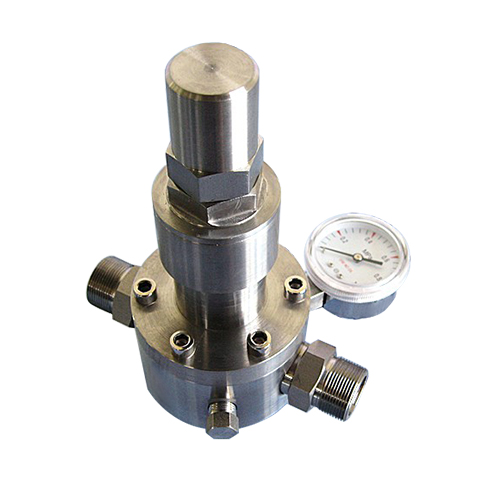Follow us
Product Details

Product Name: High-pressure Gas Pressure Reducing Valve
Product Model: YFRQBY
Product specifications: DN6-DN50
Nominal pressure: PN16-42.0Mpa
Valve material: 304, 316, etc
The non-intake state of YFRQBY high-pressure gas pressure reducing valve:
Under the prestress of the first-stage spring, the first-stage diaphragm maintains a certain gap between the lever in the first-stage lever group and the steel ball of the intake valve core, keeping the valve port in a normally open state.
Under the action of the secondary spring, the secondary diaphragm moves one end of the secondary lever downward, keeping the secondary valve port in a normally open state.
Under the action of spring tension, the three-stage lever keeps the three-stage lever and the valve seat normally closed.
Intake and working status of YFRQBY high-pressure gas pressure reducing valve:
When 25Mpa natural gas enters the first-stage pressure reducing chamber through the intake valve core group, the first-stage diaphragm gradually moves upward. When the pressure in the first-stage pressure reducing chamber reaches a certain value and the thrust of the diaphragm completely overcomes the preload force of the first-stage spring, the resultant torque acting on the lever causes the valve core to close the valve port. The gas flow rate varies with the engine load. Under the interaction of the spring and the diaphragm, the opening degree of the valve port changes at any time to ensure that the output pressure is stable at 0.4-0.6Mpa, completing the first-stage pressure reduction.
The gas that has passed the first-stage pressure reduction enters the second-stage pressure reduction chamber. As the engine load changes, the second-stage diaphragm drives the valve plate (valve) of the second-stage lever through the second-stage transmission rod to adjust the opening degree of the second-stage valve port. The opening degree of the secondary valve port is constantly changed with the variation of the flow rate in the three-stage pressure reducing chamber. The output pressure of Baote is about 0.08Mpa.
In the state of only air intake, the gas in the secondary pressure reducing chamber overcomes the tension of the tertiary regulating spring, opens the tertiary valve seat and enters the tertiary pressure reducing chamber, stabilizing the pressure in the tertiary pressure reducing chamber at 0.3-0.5KPa. When the engine starts, 0.5Kpa of low-pressure natural gas enters the engine first, which is convenient for starting. The engine operation generates vacuum suction, which pulls the three-stage diaphragm downward. The three-stage diaphragm group pushes the three-stage lever, opens the three-stage valve seat, and the gas in the two-stage pressure reducing chamber enters the three-stage pressure reducing chamber. The mixture enters the engine through the low-pressure exhaust port and the low-pressure pipe power valve. The opening degree of the three-stage valve port varies with the change of the suction negative pressure of the engine load to meet the gas flow required by various operating conditions of the engine.
Specific details can telephone consultation 021-36376357/36376358/36377909.










